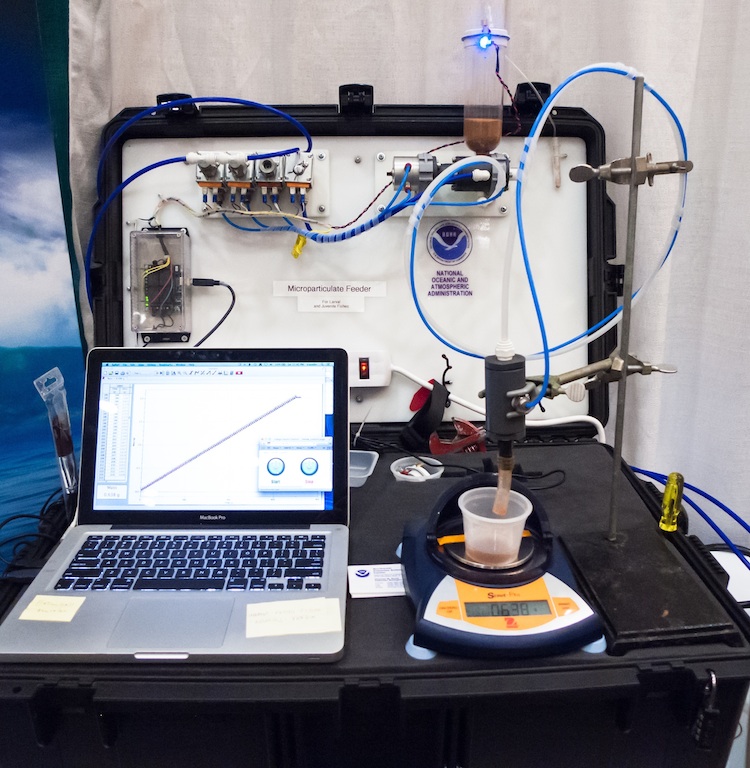
Products
NOAA develops novel micro-feeder for juvenile and larval fish
April 2, 2015 By John Mosig
 The Microparticulate Feeder for Larval and Juvenile Fish avoids the complications that can occur when dispensing fine particle fish food.
The Microparticulate Feeder for Larval and Juvenile Fish avoids the complications that can occur when dispensing fine particle fish food.NOAA Fisheries researchers in the United States have developed a fish feeder that allows hatchery operators to automatically feed young fish on a recurrent basis while protecting the feed from oxidation and clumping.
The patent-pending Microparticulate Feeder for Larval and Juvenile Fish was developed at
NOAA’s Northwest Fisheries Science Center in Seattle, Washington and is now available for licensing by a qualified US company.
The Microparticulate Feeder was developed to solve specific problems with raising larval and juvenile fish on a dry food diet.
According to Tom Scott, who developed the device for his lab, “juvenile and larval fish have very demanding feeding schedules and the diet required for these fish consists of very fine particles, which are highly susceptible to oxidation, and clumping due to excess moisture in the fish farm environment. We couldn’t find a device on the market that was meeting all our needs, so I was asked to build one.”
The device itself combines off-the-shelf solenoids and controller software with an innovative dispensing unit that uses forced nitrogen gas to both deliver the feed and keep the environment free from oxygen and moisture. The feeder can deliver small (ca. 20 mg), precise doses of microparticulate (ca. 100 µm diameter) feed to selected locations.
Gravity carries feed into a firing chamber from the hopper above. A small vibrating device aids in settling the feed into the chamber. The precision of the feeder allows for very small doses, as well as adjustments for specific diet characteristics such as dry weight equivalence and particle density. Plus, the basic controller software allows the operator to control the system and receive any warnings directly on their cell phone.
“While I was pretty sure the device would work for our R&D needs,” said Scott, “we were shocked to see such consistency over the course of many feeding runs of 100 accumulated doses. At that point, my lab director said we should call in the Technology Partnerships Office to talk about taking this to industry.”
The NOAA Micro-Particulate Fish Feeder is now patent-pending and is ready for licensing by a qualified US company. The NOAA Technology Partnerships Office has the flexibility to structure a variety of licensing agreements, based on the needs of the licensee. The goal for NOAA is facilitate a US company quickly getting the product to market.
As a mission-based science agency, NOAA Fisheries labs conduct research and development in aquaculture to support the missions of seafood sustainability and resiliency of coastal communities. NOAA scientists and engineers routinely develop innovative solutions to intractable problems in the lab. Sometimes these solutions result in an innovation that has some market potential.
Federal technology transfer legislation allows NOAA (and other federal R&D agencies) to transfer the technology to US industry under license.
To learn more about the NOAA Microparticulate Fish Feeder go to the licensing opportunity page for the device on the NOAA Technology Partnerships Office website (www.techpartnerships.noaa.gov)
Print this page
Advertisement
- LED Lighting: a new and powerful production tool for hatcheries & RAS
- Probiotics offer protection against pathogens that attack shellfish larvae





